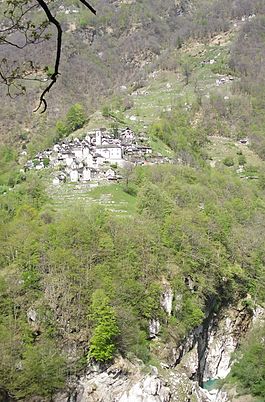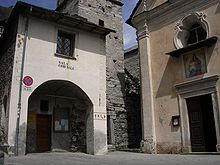- Corippo
-
Corippo Country Switzerland 
Canton Ticino District Locarno 46°14′N 8°50′E / 46.233°N 8.833°ECoordinates: 46°14′N 8°50′E / 46.233°N 8.833°E Population 15 (Dec 2009)[1] - Density 2 /km2 (5 /sq mi) Area 7.73 km2 (2.98 sq mi) Elevation 558 m (1,831 ft) Postal code 6631 SFOS number 5102 Mayor Claudius Scettrini Surrounded by Gordevio, Lavertezzo, Mergoscia, Vogorno Website www.corippo.ch
Profile (Italian), SFSO statisticsView map of Corippo Corippo is a municipality in the district of Locarno in the canton of Ticino in Switzerland.
With a population of just 17 as of December 2004[update], it is the smallest municipality in Switzerland. Despite this, it possesses the trappings of communities many times its size: an official website (www.corippo.ch), its own coat of arms, a village church, a restaurant, and a mayor who leads a town council consisting of three local citizens. The village has maintained its status as an independent entity since its incorporation in 1822.
Contents
Description
Corippo lies in the Verzasca valley some 12 kilometers (7.5 mi) from Locarno at the north end of the artificial Lake Vogorno, and 20 km from the border with Italy. The houses are built from the local Ticino granite with slate roofs and have changed little for several hundred years, leading the Italian writer Piero Bianconi to describe Corippo as "Verzasca's gentlest village". Its early 17th century Church of the Blessed Virgin Annunciata (later the Blessed Virgin Carmine) was extended in the late eighteenth century. Corippo's architectural value has caused the entire village centre to be placed under a conservation order, and in 1975 the European Architectural Heritage Congress named the village as an "exemplary model" for historical preservation.
Corippo was originally part of the larger parish and commune of Vogorno (though maintaining a certain degree of autonomy), before becoming a fully independent municipality in 1822. The village first became connected to the wider world in 1883 when a road was built linking it to the Verzasca valley road.
Depopulation has been a long-standing problem of the commune as scarceness of agricultural resources has driven the inhabitants, historically farmers and herdsmen, to move out to more populated areas, and within the last hundred and fifty years the village census has declined by over 94%.
History
Corippo is first mentioned in 1224 as Culipo. In 1374 it was mentioned as Quorippo.[2]
Geography
Corippo has an area, as of 1997[update], of 7.73 square kilometers (2.98 sq mi). Of this area, 0.07 km2 (0.027 sq mi) or 0.9% is used for agricultural purposes, while 4.95 km2 (1.91 sq mi) or 64.0% is forested. Of the rest of the land, 0.02 km2 (4.9 acres) or 0.3% is settled (buildings or roads), 0.33 km2 (0.13 sq mi) or 4.3% is either rivers or lakes and 1.81 km2 (0.70 sq mi) or 23.4% is unproductive land.
Of the built up area, housing and buildings made up 0.1% and transportation infrastructure made up 0.1%. Out of the forested land, 51.2% of the total land area is heavily forested and 3.4% is covered with orchards or small clusters of trees. Of the agricultural land, 0.8% is used for growing crops. Of the water in the municipality, 2.5% is in lakes and 1.8% is in rivers and streams. Of the unproductive areas, 17.5% is unproductive vegetation and 6.0% is too rocky for vegetation.[3]
The municipality is located in the Locarno district, on the western slope of the Verzasca valley, above the lake. It consists of the haufendorf village (an irregular, unplanned and quite closely packed village, built around a central square) of Corippo.
Coat of arms
The blazon of the municipal coat of arms is Argent a chamois sable stantant on a coupeaux vert.[4]
Demographics
Corippo has a population (as of December 2009[update]) of 15.[1] As of 2008[update], 5.6% of the population are resident foreign nationals.[5] Over the last 10 years (1997–2007) the population has changed at a rate of -34.5%. Most of the population (as of 2000[update]) speaks Italian (86.4%), with the rest speaking German.[6]
As of 2008[update], the gender distribution of the population was 53.3% male and 46.7% female. The population was made up of 7 Swiss men (46.7% of the population), and 1 (6.7%) non-Swiss man. There were 7 Swiss women (46.7%), and 0 non-Swiss women.[7] In 2008[update] there was 1 death of Swiss citizens. The total Swiss population change in 2008 (from all sources) was a decrease of 1 which represents a population growth rate of -5.3%.[5]
The age distribution, as of 2009[update], in Corippo is; there are 0 children and teenagers between 0 and 19 years old. Of the adult population, no one is between 20 and 29 years old. 1 person is between 30 and 39, 1 person is between 40 and 49, and 1 person is between 50 and 59. The senior population distribution is 5 people or 33.3% of the population are between 60 and 69 years old, 4 people or 26.7% are between 70 and 79, there are 3 people or 20.0% who are over 80.[7]
As of 2000[update] the average number of residents per living room was 0.7 which is more people per room than the cantonal average of 0.6 per room. In this case, a room is defined as space of a housing unit of at least 4 m2 (43 sq ft) as normal bedrooms, dining rooms, living rooms, kitchens and habitable cellars and attics.[8] About 54.5% of the total households were owner occupied, or in other words did not pay rent (though they may have a mortgage or a rent-to-own agreement).[9]
As of 2000[update], there were 11 private households in the municipality, and an average of 1.9 persons per household.[6] In 2000[update] there were 66 single family homes (or 98.5% of the total) out of a total of 67 inhabited buildings. There was also 1 building in the municipality that was a multipurpose buildings (used for both housing and commercial or another purpose).[10]
The vacancy rate for the municipality, in 2008[update], was 0%. In 2000[update] there were 67 apartments in the municipality. The most common apartment size was the 2 room apartment of which there were 30. There were 15 single room apartments and apartments with five or more rooms.[11] Of these apartments, a total of 11 apartments (16.4% of the total) were permanently occupied, while 56 apartments (83.6%) were seasonally occupied.[11] As of 2007[update], the construction rate of new housing units was 0 new units per 1000 residents.[6]
The historical population is given in the following table:[2]
year population 1669 41 Households 1795 269 1850 294 1900 196 1950 73 2000 22 2004 17 Sights
The entire villaggio of Corippo is designated as part of the Inventory of Swiss Heritage Sites[12]
Politics
In the 2007 federal election the most popular party was the Ticino League which received 38.46% of the vote. The next three most popular parties were the CVP (36.54%), the SP (7.69%) and the SVP (7.69%). In the federal election, a total of 13 votes were cast, and the voter turnout was 72.2%.[13]
In the 2007[update] Gran Consiglio election, there were a total of 18 registered voters in Corippo, of which 12 or 66.7% voted. 1 blank ballot was cast, leaving 11 valid ballots in the election. The most popular party was the PPD+GenGiova which received 5 or 45.5% of the vote. The next three most popular parties were; the LEGA (with 3 or 27.3%), the PS (with 1 or 9.1%) and the SVP (with 1 or 9.1%).[14]
In the 2007[update] Consiglio di Stato election, the most popular party was the PPD which received 5 or 41.7% of the vote. The next three most popular parties were; the LEGA (with 3 or 25.0%), the SSI (with 2 or 16.7%) and the PS (with 1 or 8.3%).[14]
Economy
As of 2007[update], Corippo had an unemployment rate of 0%. As of 2005[update], there were 3 people employed in the primary economic sector and about 1 business involved in this sector. No one was employed in the secondary sector or tertiary sector.[6] There were 9 residents of the municipality who were employed in some capacity, of which females made up 22.2% of the workforce.
In 2000[update], there were 6 workers who commuted away from the municipality.[15] Of the working population, 0% used public transportation to get to work, and 66.7% used a private car.[6]
Religion
From the 2000 census[update], 21 or 95.5% were Roman Catholic, while 0 belonged to the Swiss Reformed Church and 1 person belonged to another church (not listed on the census).[16]
References
- ^ a b Swiss Federal Statistical Office, MS Excel document – Bilanz der ständigen Wohnbevölkerung nach Kantonen, Bezirken und Gemeinden (German) accessed 25 August 2010
- ^ a b Corippo in German, French and Italian in the online Historical Dictionary of Switzerland.
- ^ Altitudine, superficie, secondo il genere di utilizzazione, rilevazione 1992/1997, e densità della popolazione, nel 2000 (Italian) accessed 25 October 2010
- ^ Flags of the World.com accessed 23-November-2010
- ^ a b Swiss Federal Statistical Office - Superweb database - Gemeinde Statistics 1981-2008 (German) accessed 19 June 2010
- ^ a b c d e Swiss Federal Statistical Office accessed 23-November-2010
- ^ a b 01.02.03 Popolazione residente permanente (Italian) accessed 23 November 2010
- ^ Eurostat. "Housing (SA1)" (pdf). Urban Audit Glossary. 2007. p. 18. http://www.bfs.admin.ch/bfs/portal/en/index/international/22/lexi.Document.116365.pdf. Retrieved 12 February 2010.
- ^ Urban Audit Glossary pg 17
- ^ 09.02.01 Edifici (Italian) accessed 23 November 2010
- ^ a b 09.02.02 Abitazioni (Italian) accessed 23 November 2010
- ^ "Kantonsliste A-Objekte:Ticino" (in German). KGS Inventar. Federal Office of Civil Protection. 2009. http://www.bevoelkerungsschutz.admin.ch/internet/bs/de/home/themen/kgs/kgs_inventar/a-objekte.parsys.000117.DownloadFile.tmp/ti.pdf. Retrieved 12 July 2010.
- ^ Swiss Federal Statistical Office, Nationalratswahlen 2007: Stärke der Parteien und Wahlbeteiligung, nach Gemeinden/Bezirk/Canton (German) accessed 28 May 2010
- ^ a b Elezioni cantonali: Gran Consiglio, Consiglio di Stato (Italian) accessed 23 November 2010
- ^ Swiss Federal Statistical Office - Statweb (German) accessed 24 June 2010
- ^ Popolazione residente, secondo la lingua principale e la religione, nel 2000 (Italian) accessed 23 November 2010
- Falconi, DP: Corippo in German, French and Italian in the online Historical Dictionary of Switzerland. Version of 2004-03-02.
Further reading
- (Italian) Mondada, G. (1977). Corippo. Bern: Società di storia dell'arte in Svizzera.
- (Italian) Gerosa, P.G. (1992). Un microterritorio alpino. Corippo dal Duecento all'Ottocento. ISBN 88-85115-51-9.
- English: An alpine microterritory. Corippo from the 12th to the 18th century
External links
- (Italian) Official website
- (English) Description and photo gallery
- Helvetic Administration and Public Services listing
- Swissinfo map
Ascona | Brione | Brione sopra Minusio | Brissago | Cavigliano | Centovalli | Corippo | Cugnasco-Gerra | Frasco | Gambarogno | Gordola | Gresso | Isorno | Lavertezzo | Locarno | Losone | Mergoscia | Minusio | Mosogno | Muralto | Onsernone | Orselina | Ronco sopra Ascona | Sonogno | Tegna | Tenero-Contra | Vergeletto | Verscio | Vogorno
Ticino | Districts of Canton Ticino | Municipalities of the canton of Ticino
 Categories:
Categories:- Municipalities of Ticino
- Municipalities of Switzerland
Wikimedia Foundation. 2010.




